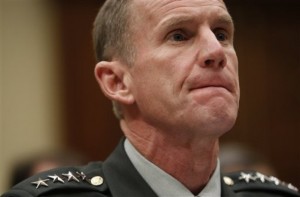Can Stan McChrystal’s Campaign Be Saved?
 The nail-biting saga of General Stanley McChrystal’s Rolling Stone interview has riveted a wide audience whose interest in Afghanistan had otherwise flagged. Shortly we’ll know whether he keeps his job, and the hyperventilating will subside over civil-military relations (On life support? Healthier than ever?).
The nail-biting saga of General Stanley McChrystal’s Rolling Stone interview has riveted a wide audience whose interest in Afghanistan had otherwise flagged. Shortly we’ll know whether he keeps his job, and the hyperventilating will subside over civil-military relations (On life support? Healthier than ever?).
McChrystal’s personality aside, however, the American government needs to figure out something much more urgent and important: Is his counterinsurgency campaign in Afghanistan working? Based on what we’ve learned in the last year, can it work at all?
President Obama hired McChrystal to turn around a war that had stagnated. He was chosen to execute a nimble counterinsurgency strategy, a campaign designed to stabilize Afghanistan and win popular support among Afghanis, harnessing military, political and economic policy.
The prior strategy wasn’t working – the Taliban had made a dramatic comeback in the years since the original invasion in 2001. Even the most vocal proponents of counterinsurgency doctrine cautioned that it had no guarantee of succeeding. To give counterinsurgency a fighting chance might require more troops, money and time than the United States was willing and able to give. (That caveat presaged some early advocates’ current view that there were never enough resources tasked to make a COIN campaign viable.)
Now the U.S. is a year into McChrystal’s plan: the halfway point to the summer of 2011 when the surge is supposed to end and American troop numbers will be reduced. So much has gone off script, however, that it raises questions about whether McChrystal’s blueprint still applies.
- President Hamid Karzai has broken ranks, frequently attacking his U.S. patrons in public.
- The Taliban has gotten stronger militarily.
- The first showcase offensive in Marjah has so far failed to stabilize the town or deny the Taliban sanctuary there.
- This summer’s major showcase offensive in Taliban-dominated Kandahar has been indefinitely postponed.
- Pakistan has derailed efforts to negotiate with the Taliban, even arresting the Taliban’s number-two when he held clandestine meetings with the United Nations.
All these events don’t prove that the U.S. can’t achieve its aims in Afghanistan – but that’s the conclusion to which they’re beginning to point. Counterinsurgency defines the toolkit the military brings to the fight; it doesn’t actually answer the question of what America should do.
Over the next year, if it hopes to establish some lasting stable order in Afghanistan, America will need a far greater unity of effort between its generals, its diplomats, its special envoys, and its friends in the Afghan and Pakistani governments. With or without McChrystal, the United States will have to make course corrections in Afghanistan as the war unfolds.
Quick briefing materials
Fred Kaplan at Slate argues that McChrystal and his loose-lipped team reveal a war effort spinning of control.
Leslie H. Gelb at The Daily Beast argues that the Democratic Party suffers from a permanent culture clash with the military.
Andrew Exum writes a thoughtful post about whether the assumptions behind the current strategy in Afghanistan still hold up. He also struggles with the implications of firing/not firing McChrystal in these two posts.
In the “Is History Repeating Itself?” department we have Rajiv Chandrasekaran’s post-mortem on the last general fired from running the Afghan year, just about a year ago.
And finally, the Michael Hastings article in Rolling Stone that kicked off the fuss, and which – the scandal aside – raises pointed questions about whether the counterinsurgency strategy in Afghanistan makes any sense.

